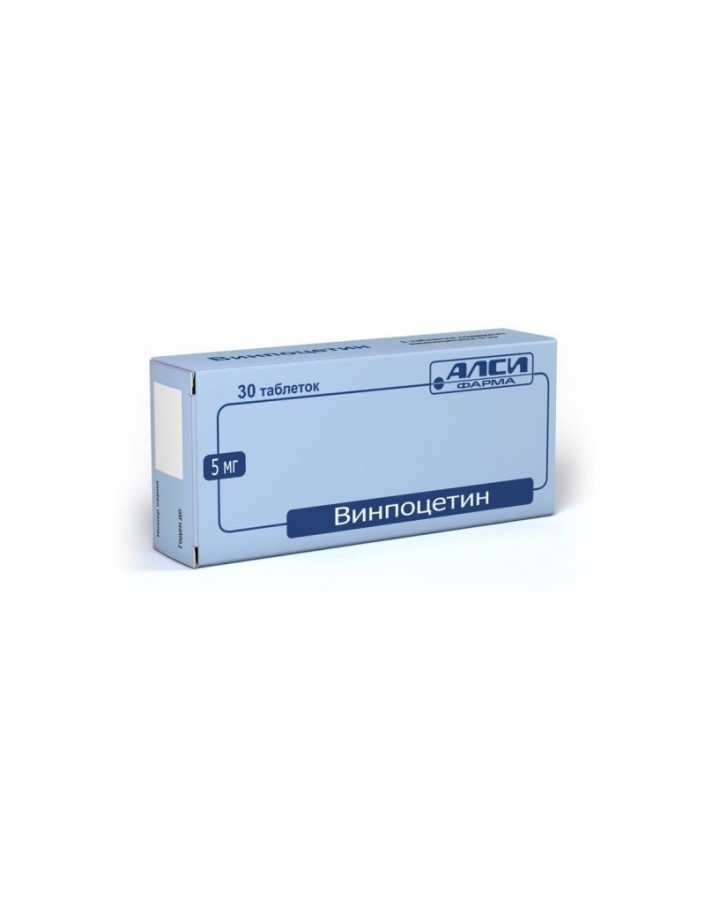




Security policy (edit with Customer reassurance module)

Delivery policy (edit with Customer reassurance module)

Return policy (edit with Customer reassurance module)
VINPOCETIN
(Vinpocetin)
Tradename: Vinpocetine
International non-proprietary name: vinpocetine
Chemical name: ethyl (3 alpha, 16 alpha) -burnamenin-14-carboxylate
Dosage Form: pills
Composition.
One pill contains:
active ingredient: Vinpocetine - 5 mg;
excipients: potato starch - 64.3 mg, lactose monohydrate (milk sugar) - 171.9 mg, colloidal silicon dioxide (aerosil) - 1.7 mg, talc - 4.7 mg, Magnesium stearate - 2.4 mg.
Description: pills of white or white with a yellowish shade of color, flat-cylindrical form with a risk and a facet.
Pharmacotherapeutic group: a means of improving cerebral blood flow.
Pharmacodynamics
Vasodilating agent. It improves brain metabolism by increasing the consumption of glucose and oxygen by the brain tissue. Increases the resistance of neurons to hypoxia; facilitates glucose transport to the brain, through the blood-brain barrier; translates the process of glucose decomposition into an energetically more economical, aerobic way; selectively blocks Ca2+Фосф dependent phosphodiesterase; increases the content of adenosine monophosphate (AMF), cyclic guanosine monophosphate (cGMP), ATP, noradrenaline, serotonin and the ratio of ATP / AMP in brain tissues; has an antioxidant effect.
Reduces platelet aggregation and increased blood viscosity; increases the deforming ability of erythrocytes and blocks the utilization of adenosine by erythrocytes; promotes increase in return by erythrocytes of oxygen.
Increases cerebral blood flow; reduces the resistance of cerebral vessels without significant changes in the systemic circulation. It does not have the effect of “stealing” and increases the blood supply, primarily in ischemic brain areas.
Pharmacokinetics
Rapidly absorbed. The time to reach the maximum concentration in the blood plasma is 1 hour. Absorption occurs mainly in the proximal gastrointestinal tract. When passing through the intestinal wall is not metabolized.
The maximum tissue concentration is noted 2-4 hours after ingestion. Communication with proteins - 66%, absolute bioavailability when taken orally - 7%, increases with the use of the drug after a meal. Clearance of 66.7 l / h. exceeds the plasma volume of the liver (50 l / h), which indicates extrahepatic metabolism.
With repeated techniques, the kinetics is linear. The human elimination half-life is 4.83 ± 1.29 h. It is excreted by the kidneys and through the intestine in a 3: 2 ratio. It penetrates the placental barrier.
Inside 5 mg (1 tab.) After a meal. The drug is used 3 times a day. The initial daily dose is 15 mg. The maximum daily dose of 30 mg. Duration of treatment up to 3 months. Possible repeated courses 2-3 times a year.
For diseases of the kidneys or liver, the drug is prescribed in the usual dose.
Before cancellation, the dosage of the drug should be gradually reduced.
On the part of the cardiovascular system: ECG changes (ST depression, prolongation of the QT interval), tachycardia, extrasystole, blood pressure lability, tidal sensation.
From the side of the central nervous system: sleep disturbances (insomnia, increased drowsiness), dizziness, headache, general weakness, increased sweating.
On the part of the digestive system: dry mouth, nausea, heartburn.
Skin allergic reactions.
Symptoms: increased severity of side effects.
Treatment: gastric lavage, taking activated charcoal, symptomatic therapy.
Interaction with other drugs
No interaction was observed with simultaneous use with β-blockers (chloranolol, pindolol), clopamide, glibenclamide, Digoxin, acenocoumarol and hydrochlorothiazide, imipramine.
The simultaneous use of vinpocetine and methyldopa sometimes caused some enhancement of the hypotensive effect, therefore, such treatment requires regular monitoring of blood pressure.
Increases the risk of hemorrhagic complications on the background of Heparin therapy.
Despite the lack of data confirming the possibility of interaction, it is recommended to be cautious with the simultaneous appointment with drugs of central, anti-arrhythmic and anticoagulant action.
The presence of prolonged QT syndrome and the use of drugs that cause prolongation of the QT interval, requires periodic monitoring of the ECG.
The effect of the drug on the ability to drive: data on the effect of vinpocetine on the ability to drive and perform work that require the speed of psychomotor reactions, no.
Release form
5 mg tablets. 10 pills in a blister pack. 1,2,3,4 or 5 blister packs with instructions for use in a pack of cardboard.
Storage conditions
In a dry, dark place at a temperature not higher than 25 ° C.
Keep out of the reach of children.